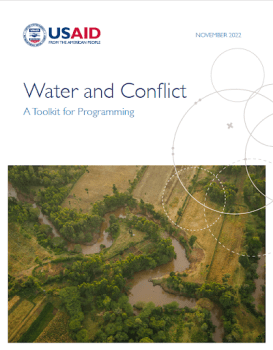Published: November 2021
Authors: Ekta Patel, Erika Weinthal, Geoff Dabelko, Carl Bruch, Jack Daly, Nikki Behnke
This practical toolkit explains the connection between water management and key risk factors associated with conflict, provides avenues for addressing those links, and suggests ways to incorporate conflict integration into WSSH programming. Its primary audience is implementing partners for water programming and USAID staff or other stakeholders who work to advance the whole-of-government White House Water Security Action Plan, the U.S. Government Global Water Strategy, and the associated USAID Agency Plan.While the toolkit is intended to guide design, implementation, and monitoring, evaluation, and learning (MEL) across all USAID WSSH programming, it is particularly relevant for programs that fall under Strategic Objective 4 of the 2022 Global Water Strategy: Anticipate and reduce conflict and fragility related to water. This toolkit is intended to serve as a resource for any organization working on issues related to WSSH to become more sensitive to conflict intersections with water programming, specifically in their ability to:
- understand the context in which it is operating, particularly with respect to inter-group relations;
- understand the interactions between its interventions and the context/group relations; and
- act upon these understandings in a way that avoids negative impacts and maximizes positive impacts.
This toolkit is divided into four parts. The first section presents the relationships between water management and conflict, cooperation, and peacebuilding. The second part explores six cross-cutting sector considerations that show the interconnections between water management and other sectors. It underscores why water programming must integrate inclusive development, incorporate a systems perspective, and plan with other sectoral interests in mind. The third section highlights best practices and program strategies from USAID WSSH programming to help design stronger and more conflict-sensitive interventions. This section also provides resources and recommendations to strengthen MEL in water programming. Lastly, the toolkit presents a conflict analysis guide for water programming with key steps and resources to help practitioners follow a structured process to identify and evaluate conflict risks and interventions throughout the USAID program cycle.
This toolkit should be used alongside other resources that address conflict integration. It is one of a series of forthcoming USAID resources that apply conflict integration to specific USAID sectors.

